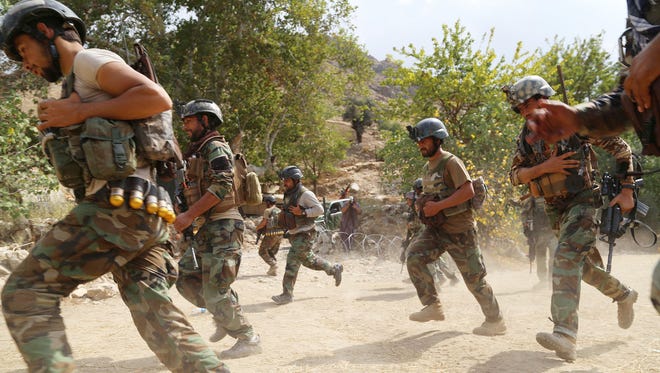Analysis: Trump's new Afghanistan war strategy reflects a lack of winning options

WASHINGTON — President Trump’s new strategy for Afghanistan reflects the lack of viable options for winning a war that has dragged on for nearly 16 years with no end in sight.
"My original instinct was to pull out," Trump said Monday night in his first major speech on Afghanistan, a conflict that is now his war. But "a hasty withdrawal would create a vacuum that terrorists ... would instantly fill."
That doesn't mean there is a clear way forward. Trump's speech sounded more like a pep rally before military personnel at nearby Fort Myer, Va., than a major strategy overhaul. Trump did not discuss details about sending more troops, would not describe the kind of military or political outcome he wants or set any timetables for how long America's longest war would continue.
“We don’t have any good options and we can’t predict the outcome of putting any of them into practice,” said Anthony Cordesman, a national security analyst at the Center for Strategic and International Studies in Washington, D.C.
While avoiding specific troop numbers, Trump has given Defense Secretary Jim Mattis authority to determine exactly how many more troops to deploy, a reflection of the president’s policy of delegating more authority to uniformed leaders.
Trump's approach clears the way for the Pentagon to send several thousand more non-combat U.S. advisers to Afghanistan. Their orders: Boost support for the country’s military, which is struggling to contain the Taliban and other militant groups that have gained ground.
There are currently about 8,400 U.S. troops in Afghanistan, down from a peak of about 100,000 in 2010 and 2011. The top coalition commander in Afghanistan, Gen. John Nicholson, said several thousand more are needed to turn the tide in a war the Pentagon has described as stalemated.
Adding forces “will be helpful but it may not be decisive,” said retired Army four-star general Jack Keane. “I’m not sure we’re willing to make the commitment to turn this thing around.”
The Taliban has gained territory as Afghan's fledgling security forces have taken high casualties to combat the growing insurgency. The Islamic State is also emerging as a threat in the country.
Trump also said he wants to place more pressure on regional allies, such as Afghanistan's neighbor, Pakistan, to help resolve the war through negotiations. The Taliban has received sanctuary and support from Pakistan and its powerful intelligence agency.
"We can no longer be silent about Pakistan’s safe havens for terrorist organizations, the Taliban, and other groups that pose a threat to the region and beyond," Trump said.
That approach is not new. Previous administrations have also attempted to place pressure on Pakistan with mixed results.
Michael O’Hanlon, an analyst at the Brookings Institution, said Trump’s strategy will likely include a “carrot and stick” approach designed to enlist Pakistan's help.
Secretary of State Rex Tillerson called Pakistan’s prime minister, India’s foreign minister and Afghanistan’s foreign minister in advance of Trump’s speech, the State Department said.
One departure from President Barack Obama's approach to the war is that the Trump administration will not set up a timeline for withdrawal, which analysts says gives hope to the Taliban and made allies in the region fearful.
Obama had drawn up a plan to withdraw nearly all U.S. forces before the end of his second term, but he later delayed the drawdown in the face of growing Taliban strength.
"A core pillar of our new strategy is a shift from a time-based approach to one based on conditions," Trump said.
“I find it hard to believe that this will be decisive,” said Seth Jones, an analyst at RAND Corp. “What it may do at least is send a message to the Taliban and people in the region that the United States is not going to withdraw.”
Contributing: Oren Dorell
More:Trump to outline new Afghanistan strategy, clearing path for troop deployments
More:President Trump 'considering his options' on Afghanistan after Camp David meeting
More:Trump stalls decision over troop increase in Afghanistan amid war strategy debate
More:Trump White House weighs unprecedented plan to privatize much of the war in Afghanistan